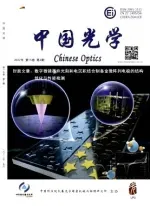LSPR spectral properties of Au nano-ring arrays and single Au nanoparticles
MA Jun-xian,TAN Rui-hu,FANG Yu,ZHENGDa-wei,LUO Xian-gang
(Advanced Technology Research Center,Shenzhen University,Shenzhen518060,China)
1 Introduction
Localized Surface Plas mon Resonance(LSPR)accounts for intense dispersion and absorption when metal nanoparticles are incited by visible light or infrared ray.It is a physical phenomenon caused by the resonant coupling between the incident electromagnetic field and the conduction electrons in the metal.When the external dielectric constant is a constant,metalnanoparticleshave an obvious absorption at a particular wavelength of the incident light and the surface plasmon wave is localized by the surrounding the metal nanoparticles.We analyze the LSPR spectral properties to study the LSPR phenomenon based on the metal nanostructure.When we change the dielectric constant,the absorption peak will shift.By using this optical characteristic,LSPR could be used in material sensors to achieve highly sensitivity. In this paper,we focus on the shifts ofLSPR absorption peak when the dielectric constant and the size of metal nanoparticles are changed.
2 Numerical simulation and parameter setting
We choose the Lorentz-Drude model to analyse the LSPR phenomenon of the metal dispersion material,and the LSPR absorption peak is calculated from Maxwell equations using a 3D Finite Difference T ime Domain(FDTD)simulation method.
The parameters of Au nano-ring array simulation are:T M plane wave;wavelength(1 220-2 600 nm);3×3 Au nano-ring array placed on the glass substrate;the height of Au ring is 40 nm with a thickness of 35 nm and the period is 400 nm.The parameters of a single Au nanoparticle simulation are: T M plane wave; wavelength(1 080 -1 400 nm);a single Au nanoparticle placed on the glass substrate;height is 40 nm,and the radius is set to 150,175,200,225,250,275 or 300 nm.The absorbing boundary condition is chosen to be a perfectly matched layer(P ML)absorbing boundary condition for all the simulations.

Fig.1 Structure of the Au nano-ring array and its energy distribution atλ=1 440 nm.
3 Results and Conclusions
Fig.1 shows the structure of the Au nano-rings array and its energy distribution atλ=1 440 nm,with the green parts in the right hand chart denoting high energy.From Fig.1 we can see that the energy is centralized on the edges of particles,which means the energy absorption of the incident light is concentrated in the exterior of the Au nano-rings.
In order to study the relationship between the dielectric constant and the absorption peak,we setn=1,1.3,1.4 respectively,and the results are shown in Fig.2.We can see the absorption peak locates at 1 500,1 800,1 900 nm,respectively,and the position of absorption peak is red-shifted when the dielectric constant is increasing.The peak is shifted about 100 nm while the dielectric constant increases by 0.1.

Fig.2 Absorption spectrum ofAu nano-rings.

Fig.3 Comparison of a single Au nanoparticle and 3×3 Au array.
Then we undertook a comparative experiment of a single Au nanoparticle and a 3×3 Au array to deter mine whether the period affects the absorption peak,andwe used anAu nanoparticlewith the same radius and height. It was found that the period has little effect on the absorption peak position,but has a large affect on absorption intensity,as shown in Fig.3. That means the periodical nano-structures can localize and enhance the electromagnetic field selectively,leading to a stronger absorption.

Fig.4 Structure of single Au nanoparticle and its energy distribution atλ=1 380 nm.
At last,we investigate LSPR spectral properties of a single Au nanoparticle and discuss the relationship between the absorption peak and the size of a single Au nanoparticle by performing 7 comparative exper iments.We present the structure of single Au nanoporticle and its energy distribution in Fig.4.We also found that the energy is centralized on the edges of particles as shown in Fig.1.
From the left chart in Fig.5,we can see that the absorption peak is red-shifted when the radius of Au nanoparticle is increasing. The right picture shows a linear relationship be tween the radius and the location of absorption peak,and the wavelength of absorption peak increases when the radius is increasing.There are two inflection points between 150 nm and 175 nm and between 275 nm and 300 nm,respectively. Furthermore,we can seethe slope between 150 nm and 175 nm is larger,which means the Au nanoparticle whose radius is smaller than 175 nm ismore sensitive around the absorption peak.

Fig.5 Absorption spectrum of anAu nanoparticle of different sizes and the relationship be tween the radiusof theAu nanoparticle and peak position.
3 Conclusions
From our s imulation experiments,we can conclude that the absorption peak will shiftwhen the dielectric constant is changed,and the intensity of absorption is related to the dimension of the single particle.The periodic nanostructure can localize and enhance the electromagnetic field selectively,therefore,its sensitivity can be improved by increasing the number of periodic particles.Furthermore,there is a linear relationship between the radius and the absorption peak,and the two inflection points. The result means that Au nano-particles are more sensitive to the change ofwavelength when the radius is below a certain value,so we can control the position of the LSPR absorption peak by designing different sizes of metal nanoparticles.
[1] TOM INAGA J,TSA ID P.Optical Nanotehcnologies-the M anipulation of Surface and Local Plasmons[M].Heidelberg,Springer,2002:512-515.
[2] K IM S,JUNGJM,CHO ID G,et al..Patterned arraysofAu rings for localized surface plasmon resonance[J].Langm uir,2006,22(17):7109-7112.
[3] STUARTD A,HAESA J,YONZON C R,et al..Biological applications of localized surface plas monic phenomenae[J].IEEE Proc.Nanobiotechnol.,2005,152(1):13-32.
[4] EL-SAYED M A.Some interesting properties ofmetals confined in time and nanometer space of different shapes[J].Acc.Chem.Res.,2001,34(4):257-264.
[5] HUTTER E,FENDLER J H.Exploitation of localized surface plasmon resonance[J].Adv.M ater.,2004,16(19):1685-1706.
[6] L INK S,EL-SAYED M A.Spectral properties and relaxation dynamics of surface plasmon electronic oscillations in gold and silver nano-dots and nano-rods[J].J.Phys.Chem.B,1999,103(40):8410-8426.
- 中國(guó)光學(xué)的其它文章
- I nvestigation on spontaneously generated coherence
- All-fibre flat-top comb filter based on high-birefringence photonic crystal fibre loop m irror
- Multiple 3D optical trapp ing using higher polarization order axially-symmetric polarized beams
- Tailoring the properties of opticalmetamaterials
- Negative permeability in planar metal-dielectric composites
- Strong dual band metamater ial absorber in terahertz regime

